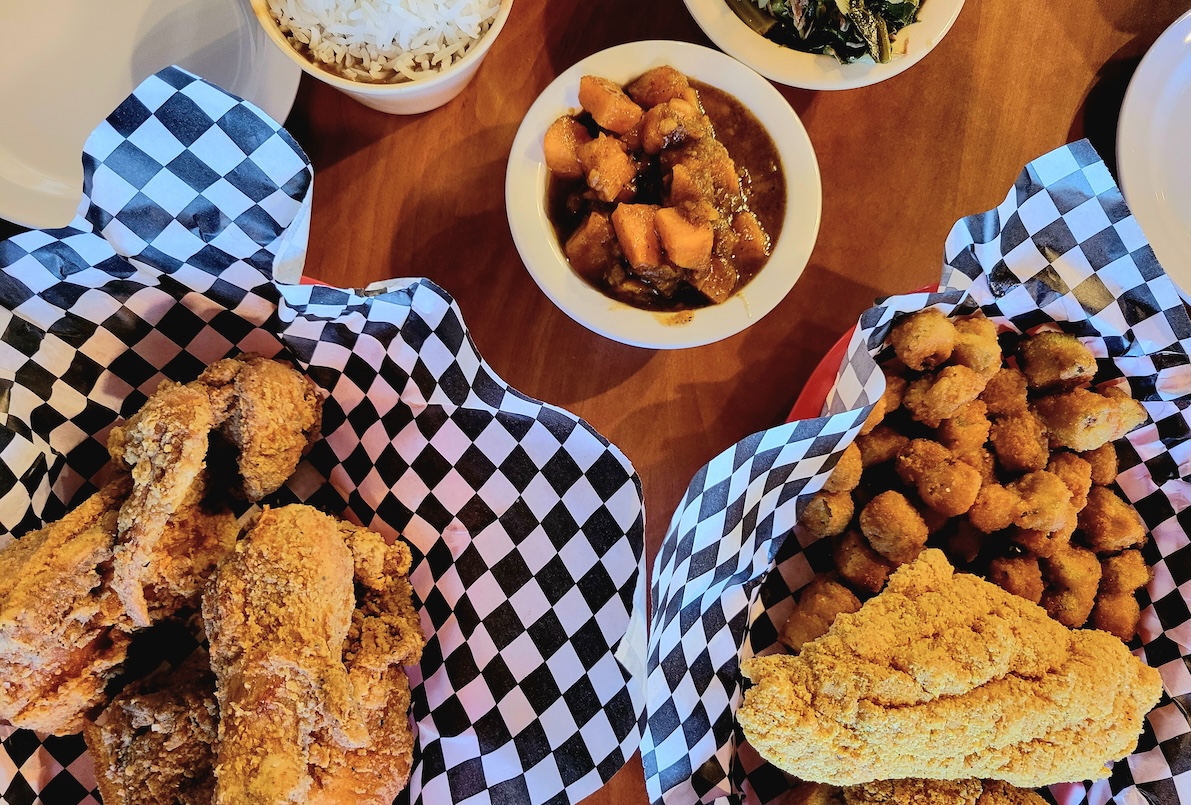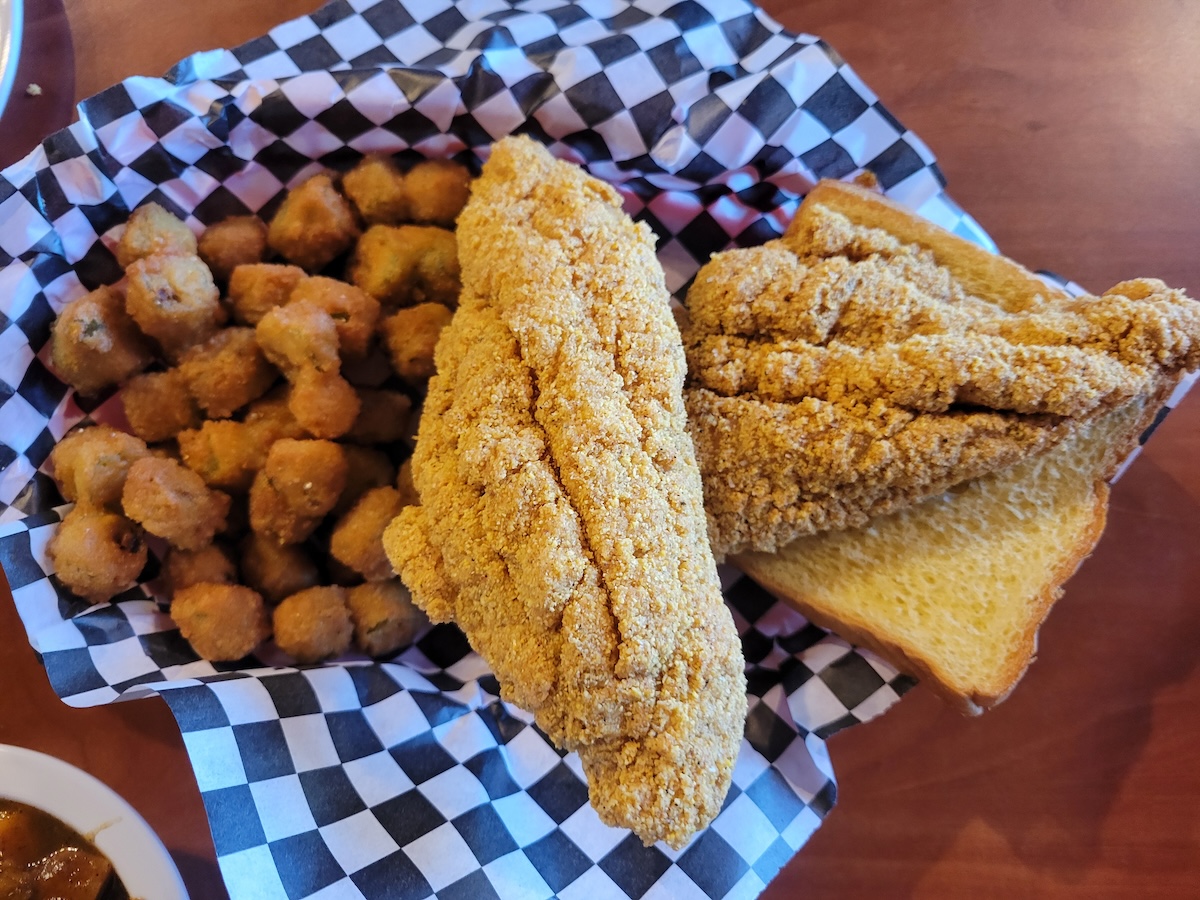Meet some of Colorado’s celebrities and find out where they like to eat and drink.
If anyone knows anything about soul food, it’s Adrian Miller. In fact, he wrote a book all about it, as well as two others. We sat down with the writer and historian at one of his favorite soul food spots in Denver, Blazing Chicken Shack II.
Owners Leola Gant, Rhonda Banks, and Gail Ray Moore opened Blazing Chicken Shack II in the Park Hill area in March, 2017. The goal was to create a comfortable place to welcome and feed anyone who walked through the doors. While we aren’t 100-percent sure of the reason, we believe the number two in the name comes because the first Blazing Chicken Shack was a food truck run by Gant and Banks. Either way, it’s become a neighborhood staple serving up true soul food.
So, of course we dived in. The menu features iconic iitems such as smothered pork chops, fried chicken, hot links, black eyed peas, collards, and fried gizzards. Entrees hover between $16 and $22, and sides run around $5 a piece. Sandwiches, wings and starters cost between $8 and $12. Yes you will want hot sauce, no you won’t need salt.

We let Miller lead the charge in ordering, a decision well played. He picked up the cornmeal-crusted catfish with sides of fried okra and collards with cabbage and turkey. We also got the fried half chicken, choosing candied yams and red beans with rice. It all hit perfectly, though the collards, chicken, and fish were the stars of our lunch.
When it comes to soul food in and near Denver, Miller knows his stuff, and not just because he wrote about it. Though, he has published three non-fiction books including Soul Food: The Surprising Story of an American Cuisine, One Plate at a Time; The President’s Kitchen Cabinet: The Story of the African Americans Who Have Fed Our First Families from the Washingtons to the Obamas; and the latest, Black Smoke:African Americans and the United States of Barbecue. For Miller the deep dive into the cuisine centers around his role as a black man and the important culture behind black food.
To dig into the soul food and black food culture of the Mile High City, and to dig into our platters of fried food, we peppered Miller with questions, one bite at a time.
What made you choose Blazing Chicken Shack II?
So I picked this place because I love supporting black-owned restaurants and I love soul food. This is one of the two places I love the most in Denver. Well, this is the one I love the most in Denver, the other one is in Aurora, [Cora Faye’s Cafe].
It’s a woman-owned business too, so that’s another reason to support it. So you know, the role of black women in soul food is pretty established, but it’s all overlooked. I mean, even in barbecue, black women have a strong presence, Especially in restaurant culture, which I don’t know if you see that in a lot of other cultures.
I just love what they do here. I’m a big catfish fan, and they do catfish really well. And the chicken is slamming. So those are just two things I like. Plus, they have quirky soul food, like you can get a pig ear sandwich here.
Why is that quirky?
Because it’s not something you see in a lot of places. I like them if they’re made the right way. I know it sounds disgusting, but it’s almost like a very luscious thing to eat. These are pressure cooked so they’re just really tender.
How long have you been coming here?
Wow, I want to say five years. And they’ve been around longer than that. But for whatever reason, I just never made it over here. So kind of a coincidence, I actually grew up not too far from here. During the first part of my life I lived at 35th and Newport, which is just like six blocks from here. And then when I was a little kid, we moved to Aurora. So I actually grew up in Aurora.

When coming here I actually thought it was in Aurora.
Yeah, this is technically Denver. We’re in Park Hill, which is historically, for at least the last 40 years, a historically black neighborhood. It’s changing, gentrifying, but we’re on the black side of Park Hill, not too far from the Hiawatha Davis Jr Recreation Center. So I love this place.
What is soul food exactly?
I’ve learned a lot in the last 20 years since I started this journey. I think for a lot of people soul food is shorthand for all black cooking. But it’s just much more complex than that. The challenge for me is trying to give a definition that’s not too academic. So basically, soul food is the food that African Americans took out of the South and transplanted in other parts of the country during the Great Migration.
It’s not exactly southern food, because, you know, when you’re in a place with a good climate and all these other things, you’ve got a lot more stuff available. Like when we think of greens, I mean, there’s like at least ten types of greens in the South. But once you get outside of the South because of the climate difference, it changes and a standardized menu develops.
How should we think about soul food?
I’m trying to get people to think of soul food as a migrant cuisine. What happens in restaurants, at least in the United States, the food that we think of is usually the celebration food of that culture. As a restaurateur, you don’t want to do the everyday stuff, right. You want to show off the very best of your culture. So you’re usually doing celebration food. Now, if you’re outside of that culture, you walk into a restaurant, you’re like, oh, this is what they eat every day.
So like fried chicken?
Yeah. Not only was it a Sunday supper thing, but it was seasonal. You would really only eat fried chicken during a certain part of the year. The early folk wisdom about fried chicken is that you would get a chicken when it was about a year old. So a spring chicken, because they hatch in the spring. If it was older than that, you would use other cooking methods like stewing or something else.

A lot of people think soul food and southern food are interchangeable, what’s the difference?
You know, once food leaves a place, that’s when it gets a name. Because even today, if you go to the south and you eat the very same food, they’re not going to call it southern cooking. They’re just going to say it’s just dinner.
But, if I’m being glib, I’ll say soul food tastes better. If I want to be really provocative, I’ll say because black people made it. The way it’s prepared, soul food tends to use cheaper cuts of meat. So it’s going to be bone in. It’s the difference between having say a catfish filet or a whole catfish on the bone.
Overall, I talk about soul food as bringing together the culinary techniques, traditions, and ingredients of West Africa in Western Europe and the Americas. So all of this stuff came together in the South before the 1960s. Even though the term soul food was floating around in black culture before that, regardless of who made it, it was all called southern cooking. And then there we go, another level. So that’s a lot of confusion.
There are also stereotypes surrounding this cuisine too, right?
One of the biggest things, when people say soul food one of the things they think about is like, oh, that’s slave food or that’s food that’s going to kill you. So this narrative has developed that soul food is really the food of slavery in a modern context. Though that’s part of the story, soul food is much more.
So what’s next for Adrian Miller?
I would like to write about the history of black people in Colorado. Oh, we’ve had some high level people here. And my first step in doing this is the exhibit that I created for the Museum of Boulder, a black history exhibit [called Proclaiming Colorado’s Black History, on until September 30, 2025].
Pick up Adrian Miller’s books at your local bookstore, head to the Boulder Museum, and visit Blazing Chicken Shack II for a true taste of soul food. The restaurant isn’t fancy, or easy to spot thanks to the lack of clear signage, but it’s worth the trip. 5560 E. 33rd Ave., Denver, blazingchickenshackii.com

